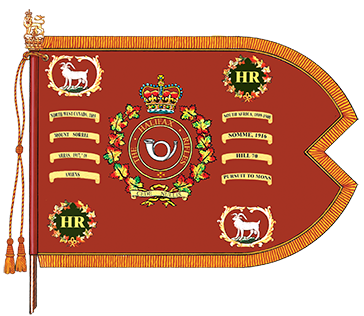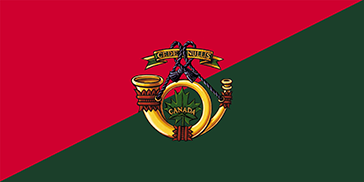The Halifax Rifles (RCAC)
The official lineage of The Halifax Rifles (RCAC) armour regiment.

Badge
Description
On an eight pointed star Argent a hunting horn Or embellished Gules encircling a maple leaf Vert inscribed with the word CANADA in letters Or, the horn pendent from cords Sable enfiling a motto scroll Vert edged and inscribed CEDE NULLIS in letters Or below a like scroll inscribed THE HALIFAX RIFLES and ensigned by the Royal Crown proper.
Symbolism
The star is of a type favoured by Canadian regiments in Victorian times. The maple leaf represents service to Canada, and the Crown, service to the Sovereign. The regiment's rifle heritage and their regimental march, the "Huntsman's Chorus", is symbolized by the horn. Both green and black are important colours used in rifle regiment uniforms. "THE HALIFAX RIFLES" is a form of the regimental title and "CEDE NULLIS" is the motto of the regiment.
Motto
CEDE NULLIS (Yield to None)
March
Huntsman's Chorus
Guidon

Camp flag

Battle honours
The War of 1812
Honorary Distinction
The non-emblazonable honorary distinction DEFENCE OF CANADA – 1812-1815 – DÉFENSE DU CANADA (awarded in commemoration of the Nova Scotia Fencible Infantry)
North West Rebellion
NORTH WEST CANADA, 1885.
South African War
SOUTH AFRICA, 1899-1900.
The First World War
MOUNT SORREL; SOMME, 1916; ARRAS, 1917, '18; HILL 70; YPRES, 1917; AMIENS; HINDENBURG LINE; PURSUIT TO MONS.
Lineage
This Reserve Force regiment originated in Halifax, Nova Scotia on 14 May 1860, when the 'Halifax Volunteer Battalion' was authorized to be formed.Footnote 1 It was redesignated: 'Halifax Volunteer Battalion of Rifles' on 28 May 1869;Footnote 2 '63rd The Halifax Volunteer Battalion of Rifles' on 5 November 1869;Footnote 3 '63rd The Halifax Battalion of Rifles' on 13 May 1870;Footnote 4 '63rd Regiment "Halifax Rifles"' on 8 May 1900;Footnote 5 'The Halifax Rifles' on 15 May 1920;Footnote 6 '2nd (Reserve) Battalion, The Halifax Rifles' on 1 January 1941;Footnote 7 'The Halifax Rifles (Reserve)' on 15 September 1944;Footnote 8 and 'The Halifax Rifles' on 30 November 1945.Footnote 9 The regiment was converted to armour and redesignated: '23rd Armoured Regiment (Halifax Rifles), RCAC' on 1 April 1946;Footnote 10 'The Halifax Rifles (23rd Armoured Regiment)' on 4 February 1949;Footnote 11 and 'The Halifax Rifles (RCAC)' on 19 May 1958.Footnote 12 It was reduced to nil strength and transferred to the Supplementary Order of Battle on 31 January 1965.Footnote 13 On 28 July 2009, it was removed from the Supplementary Order of Battle.Footnote 14
Notes:
Upon redesignation as The Halifax Rifles on 15 May 1920 (see above), it was organized as a two battalion regiment with the 1st Battalion (40th Battalion, CEF) on the Non Permanent Active Militia order of battle, and the 2nd Battalion (no CEF designation) on the Reserve order of battle. The reserve unit was disbanded on 14 December 1936 (GO 3/37).
The Halifax Rifles were disbanded for the purpose of reorganization on 15 July 1920 and reorganized the same day (GO 157/20). This change was administrative and does not affect the lineage of the regiment.
On 22 December 1964, The Halifax Rifles (RCAC) and The Princess Louise Fusiliers were ordered to effect an amalgamation as an infantry battalion under a "to be determined" designation by 31 March 1965 (SD 1 Letter No. 64/68). This amalgamation was cancelled through Amendment 1 to SD Letter No. 64/68 (EASCOM Msg G 5631 of 22 Sep 65).
Perpetuations
'40th "Overseas" Battalion, CEF'
Headquarters Location
Halifax, Nova Scotia
Operational history
Fenian Raids
The Halifax Volunteer Battalion was called out on active service on 6 June 1866. The battalion, which served on guard duty at the Halifax Dockyard, was removed from active service on 31 July 1866.Footnote 15
North West Rebellion
The 63rd The Halifax Battalion of Rifles mobilized three companies for active service on 10 April 1885.16Footnote 16 The companies served with the 'Halifax Provisional Battalion' in the Alberta Column of the North-West Field Force.Footnote 17 The companies were removed from active service on 24 July 1885.Footnote 18
South African War
The 63rd The Halifax Battalion of Rifles contributed volunteers for the Canadian Contingents during the South African War.Footnote 19
The First World War
Details of the 63rd Regiment "Halifax Rifles" were placed on active service on 6 August 1914 for local protective duty.Footnote 20
The 40th Battalion, which was authorized on 7 November 1914 as the '40th Battalion, CEF',Footnote 21 embarked for Britain on 18 October 1915.Footnote 22 The battalion provided reinforcements to the Canadian Corps in the field until 4 January 1917, when its personnel were absorbed by the '26th Reserve Battalion, CEF'.Footnote 23 The battalion was disbanded on 17 July 1917.Footnote 24
The Second World War
Details from the regiment were called out on service on 26 August 1939 and then placed on active service on 1 September 1939, under the designation 'The Halifax Rifles, CASF (Details)', for local protection duties.Footnote 25 The details called out on active service were disbanded on 31 December 1940.Footnote 26 The regiment mobilized the '1st Battalion, The Halifax Rifles, CASF' for active service on 1 January 1941.Footnote 27 It was converted to armour and redesignated: '23rd Army Tank Battalion (The Halifax Rifles), CAC, CASF' on 26 January 1942;Footnote 28 and '23rd Army Tank Regiment (The Halifax Rifles), CAC, CASF' on 15 May 1942.Footnote 29 It embarked for Britain on 17 June 1943 as a unit of the 2nd Army Tank Brigade, 4th Armoured Division, where it provided reinforcements to units of the Canadian Corps in the field.Footnote 30 The overseas regiment was disbanded on 1 November 1943.Footnote 31
Page details
- Date modified: